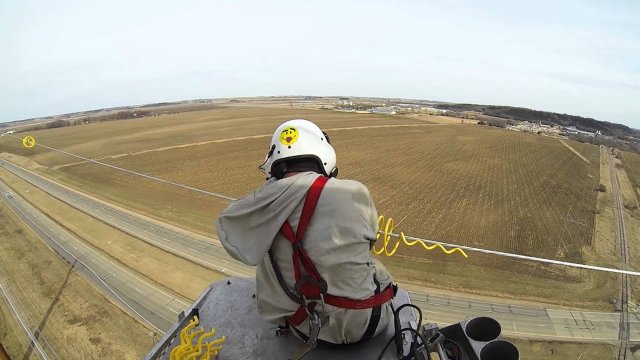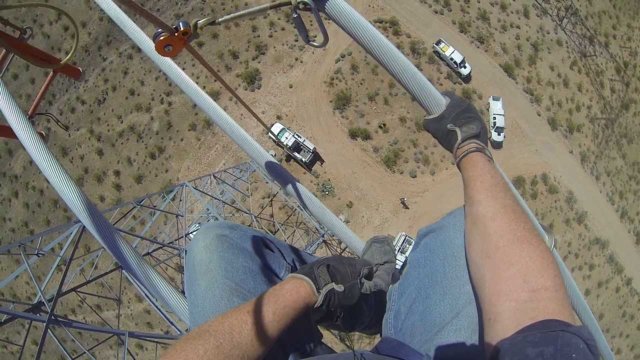The University of Twente is developing drones that will make high-altitude work on high-voltage power lines safer and more efficient. The installation of bird diverters and spacers on these lines is still done by humans and is life-threatening work. The UT Robotics and Mechatronics (RAM) lab has now built a working prototype that will soon be tested on high-voltage power lines. The robots will initially be used for the high-voltage infrastructure in Spain.
The University of Twente is cooperating with nine partners in the European AERIAL-CORE project to develop an innovative platform for robots that can carry out inspection and maintenance work at great heights, for example on high-voltage power lines or wind turbines. The European Commission’s Horizon2020 research programme is investing €8.6 million in the project. This is the largest European research budget ever in the field of aerial robots. The Spanish energy company ENDESA is one of the ten partners in this project and will deploy the drones in practice. There may also be uses for drones in the Netherlands.
Unique robot skills
Dr. Antonio Franchi, a well-known name in the field of international aerial robotics, is a work package coordinator in the AERIAL-CORE project on behalf of the University of Twente. He joined UT and the RAM research group a year ago. “In this project, we are focussing on new robotic technologies for the inspection and maintenance of large-scale infrastructure,” explains Franchi. “The drones are programmed with skills that are unique in the world for this type of robot. They can inspect infrastructure over long distances, but also carry out very precise and localised maintenance. In the future, human technicians will be able to leave dangerous maintenance tasks up to these drones and coordinate the work from the ground. The drones have robotic arms that can exert sufficient force while hovering in the air. Human-robot interaction is also an important part of the project.”
Cooperation and energy consumption
The UT researchers are focusing primarily on improving the cooperation between the drones and their human operators. The robots have to physically interact with humans at great heights, whereby safety, ergonomics and optimum performance of the tasks are essential to the cooperation. The robots must also be able to interpret the operator’s actions. “We are looking at sensors that can monitor human movements and translate these into commands for the robot,” explains PhD student Amr Afifi, who is collaborating on the project. They are also looking into augmented reality solutions that can help the human operator to follow the movements of the aerial robot.
Quentin Sablé, mechatronic engineer within the UT’s RAM research group, is also analysing the energy consumption of the robots. “The drones perform physical interaction tasks, but also spend a lot of time flying to their destination,” explains Sablé. “Carrying out physical operations requires a different configuration of motors and propellers than when the robot is simply hovering or approaching. We want to build an aerial robot that can easily switch between flying mode and working mode.”
Installing bird diverters and spacers
Two examples of specific situations for which the drones are being developed are the installation of bird diverters and spacers, both on high-voltage power lines. In many countries, bird diverters are installed every few meters on high-voltage power lines to prevent birds from flying into them at high speeds, which kills the birds and increases the temperature of the lines, a potentially hazardous situation. This is a risky job that is currently still carried out by people. With the AERIAL-CORE project, the installation of spacers and bird diverters will be carried out completely or semi-automatically by drones.
The robotic arms of the drone are equipped with end effectors (also known as end-of-arm tooling) and are provided with visual sensors, whereby it’s possible to control the drone from the ground. But more importantly; the sensors can retrieve human configuration and gestures in real-time. Because of this, the aerial vehicle can recognize human operator activities and can prevent any hazardous situations. For example, the robot can give the operator precise directions on where to place the bird diverters.
The researchers have been allocated a section of line in the ATLAS flight center with restricted airspace to test the drones.
installation of a bird diverter in the US
Installation of a spacer on high-voltage lines
About Antonio Franchi
The "Aerial Co-Worker" work package of the Aerial-Core project is being coordinated on behalf of the UT by Dr. Antonio Franchi, who was also part of the team that conceived the project in 2019. At that time, he was still working at the National Center for Scientific Research (CNRS) in France. He transferred the CNRS’s part of the project to the UT shortly after moving there himself, now over a year ago. The robotics department thus launched a new and innovative line of research in the field of cooperation between humans and aerial robots. “It is a great challenge and an honour to embark on this new adventure as a UT researcher in the RAM group,” says Franchi. “The fact that we have managed to secure such a large research budget is a wonderful milestone. It will enable us to take major steps forward in the area of human-robot cooperation and we will be able to significantly reduce the dangers for human technicians. That is what we are doing it for.”







